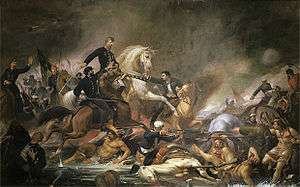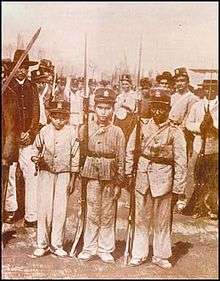Battle of Acosta Ñu
| Battle of Acosta Ñu | |||||||
|---|---|---|---|---|---|---|---|
| Part of the Paraguayan War | |||||||
 Battle of Campo Grande, by Pedro Américo. | |||||||
| |||||||
| Belligerents | |||||||
| Commanders and leaders | |||||||
| Bernardino Caballero | Count d'Eu | ||||||
| Strength | |||||||
| 3,646, 12 cannon[1]:103 | 1st and 2nd Corps[1]:103 | ||||||
| Casualties and losses | |||||||
| |||||||

The Battle of Acosta Ñu or Campo Grande (Guaraní: Acosta Ñu ñorainõ) was a battle during the Paraguayan War, where, on August 16, 1869, between the Triple Alliance and Paraguay. The Paraguayans used many boys in the fighting, wearing false beards and carrying old weapons.[1]:104
Background
In the middle of 1869, the Paraguayan Army was on the run and Asunción was under allied occupation. Francisco Solano López, the Paraguayan president, refused to surrender and fled, vowing to keep fighting to the end. The Brazilian commander Luís Alves de Lima e Silva, Duke of Caxias suggested that the war was militarily over, but Pedro II, the Brazilian emperor, refused to stop the campaign until López surrendered. Caxias resigned and was replaced by the Emperor's son-in-law, Luís Filipe Gastão de Orléans, Count of Eu.
Count d'Eu and the main Allied troops advanced and took Caacupé on August 15, though López had already fled to Caraguatay. In an attempt to block the Paraguayan Army from retreating to Caraguatay, the Count of Eu sent the 2nd Corps via Barrero Grande, while the 1st Corps pursued López.[1]:103
Battle
The Allied troops met the rearguard of the Paraguayan forces at Acosta Ñu on August 16. The battle started at 0800. Acosta Ñu (which means "Acosta's Field", "Acosta" being a popular last name) is a vast plain of roughly 12 km2 (4.6 sq mi), ideal for the Brazilian cavalry. The initial charge was led by the Allied 1st Corps infantry, supported by artillery. As the Paraguayans retreated across the Yagari River, the 4th Cavalry Brigade made a right flanking movement. Meanwhile, the 2nd Corps reached the Paraguayan rear, which left them no means to retreat. Children were said to clung to the legs of Brazilian soldiers amidst the raging battle, pleading for mercy, only to be decapitated without hesitation. Once all flanks collapsed, the wounded children tried to flee the battlefield alongside their relatives. Yet the Brazilian commander ordered his cavalry to cut the retreat and set the battlefield ablaze, including the field hospital. Large numbers of children died because of these actions.[1]:104
Legacy
The battle of Acosta Ñu/Campo Grande is depicted in the famous painting Batalha de Campo Grande by Pedro Américo, and in the book Recordações de Guerra e de Viagem by famous Brazilian writer Visconde de Taunay, who took part in the battle.
In Paraguay, Children's Day is celebrated on August 16. It is a national holiday to commemorate the memory of the children who lost their lives in the Battle of Acosta Ñu/Campo Grande.